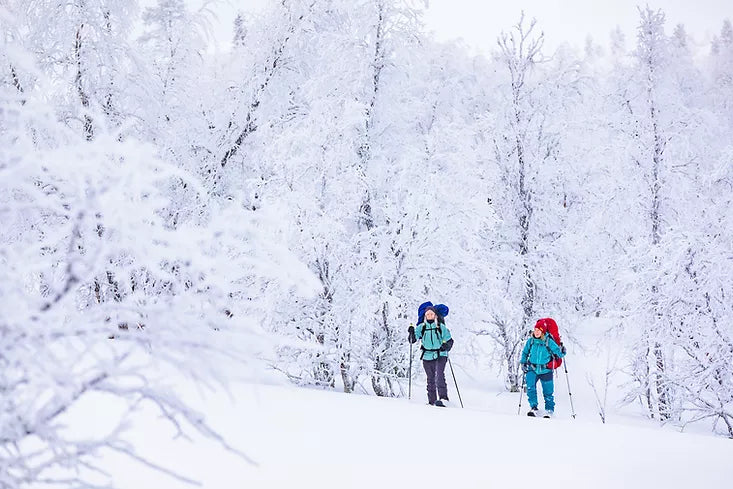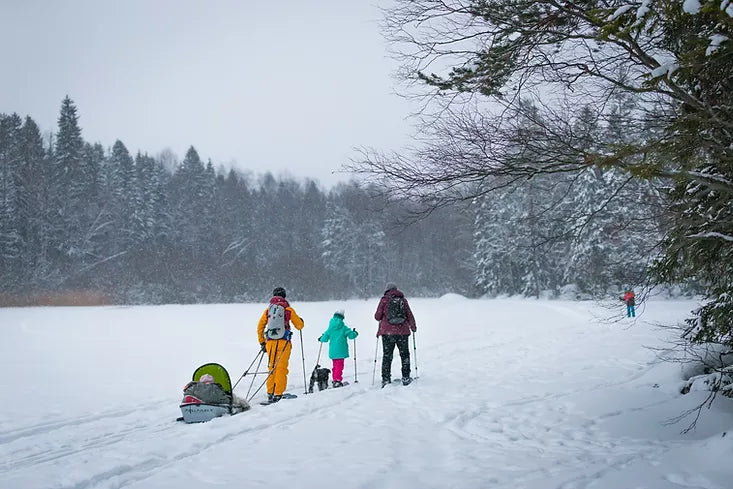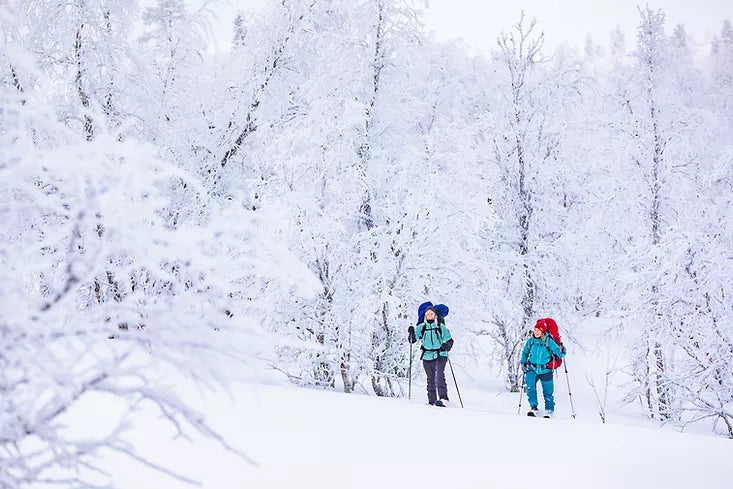At Skinbased, our desire to create and produce skis stems directly from our passion for Nordic backcountry skiing. While still our first love, in recent years we have developed a deep affinity for a second winter activity; the relatively new sport of snow trekking!

What is snow trekking?
When you combine Nordic backcountry skiing with snowshoeing, you get snow trekking. A snow trekker itself is a combination of a ski and a snowshoe. It looks like and slides like a ski, but also has features that compare to snowshoes such as excellent floatation and good climbing qualities.
The sport of snow trekking involves traveling through winter landscapes, both on and off-trail, and across a myriad of terrain types and conditions. While all snow types will do, snow trekking is at its best when the snow is deep. With snow trekkers you can go easily up and down hills, across the flats, and explore the backcountry.
Our Skinbased snow trekker line offers superb stability, floatation, and mobility, allowing you to experience even the deepest snows and thickest forests. Their short lengths and wide design means you can travel through terrain other skis simply can't. Snow trekking outings can range from anything from a quick tour around the backyard to multi-week expeditions.
Basic snow trekking techniques
The basic technique of snow trekking is very simple: Just like in traditional cross-country skiing, you alternate sliding your feet and skis forward, one in front of the other. Unlike cross-country skiing, the slide is rather short and slow. Thus, the tempo in snow trekking is closer to that of snowshoeing than skiing.
When going uphill, there are few possible techniques to use: First, if the hill is not too steep, you can ascend straight up. The climbing skin ensures that the sliding snowshoe does not slide backwards. However, the steeper the hill gets, the more beneficial it can be to use either side stepping or traversing techniques.
Side stepping begins with orienting yourself so that the side of your body facing up the hill. Begin the movement by stepping your uphill ski farther up the hill, and then move the downhill ski up to meet it. Repeat this “side stepping” motion all the way to the top of the incline, always remembering to keep your body and skis parallel to the slope.
If the side stepping technique feels too exhausting for the terrain, traversing is always a good option to reach the top. Instead of climbing directly up the incline, one moves across the slope, traveling from side to side, while maintaining a slight upward angle. This will make a zigzag-shaped track up the hill. Directional changes are made by employing a kick turn, a technique where the tip of the uphill ski is lifted above the snow and rotated 180 degrees, so that it is nearly parallel (but facing the opposite direction) to the other ski. To finish, lift and turn the other ski, so that both skis now face the same direction.
Snow trekkers are not the best skis to use for cruising down steep hills unless you are a very skilled skier who has previous experience on Skinbased skis. However, with the above-described traversing technique, you can easily reach the bottom of the hill at a slower pace, and via the route that matches your skills. Of course, as your skills improve, the more difficult routes you can take. To start with though, we always recommend exercising caution and beginning with only gently sloping hills. Personally, we find snow trekking is simply more fun when the routes are not overly-difficult.
A sport for the whole family
The skills required for snow trekking are few, and many of the more technical ones, such as developing basic Nordic ski techniques, can be learned while doing. Consequently, the sport is very easy to start no matter what your background or age is. Snow trekking is also a great activity to do with your furry friends!
Other helpful skills can include skiing experience and a familiarity with cross-body pole techniques, the same ones used for hiking or Nordic skiing. Additionally, those skill sets associated with other winter outdoor activities, such as clothing layering, first aid, and wilderness preparedness, can ensure that your sliding snowshoeing adventures are fun and safe.
Snow trekking is great for the whole family, and as such we have constructed some of our snow trekkers without metal edges, to increase safety when used around children and pets. We offer models for both adults and kids: the KAR and WAP for grown-ups and teenagers, and the POH for kids aged 5-10. Keep them at the cabin, by the front door, or even in the back of the car so you will always be ready for a snowy adventure.


0 kommentarer